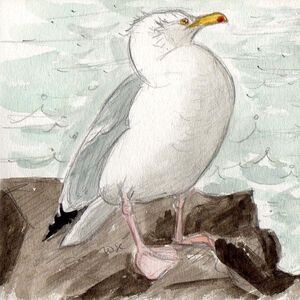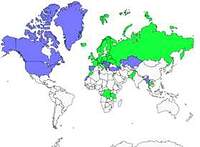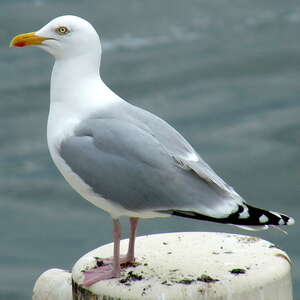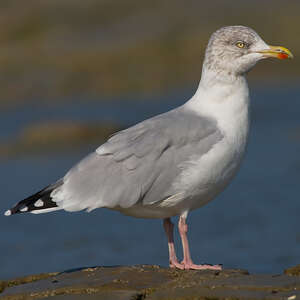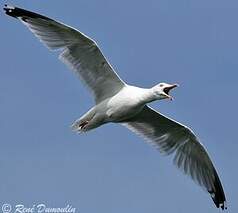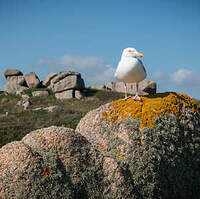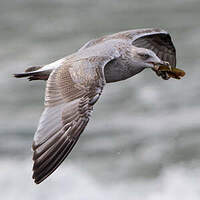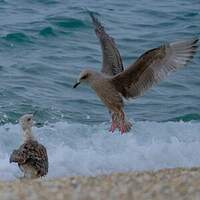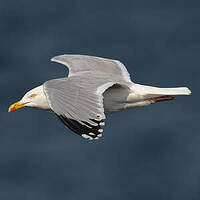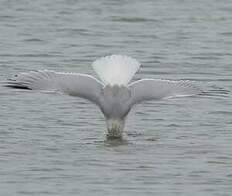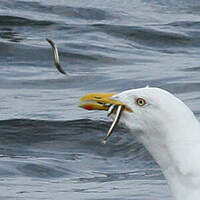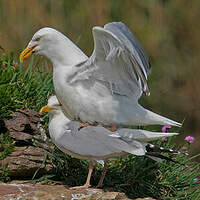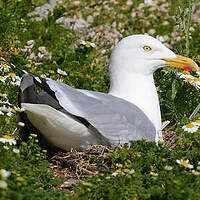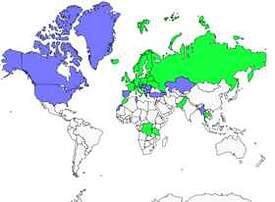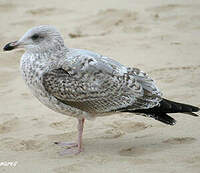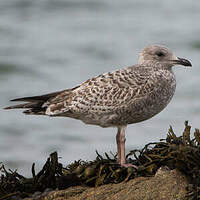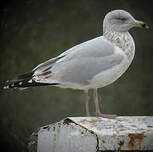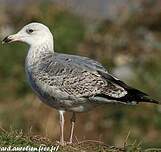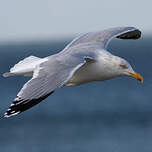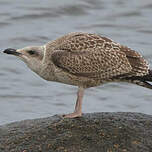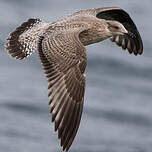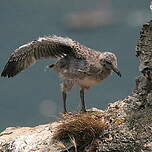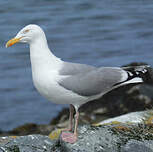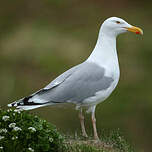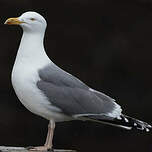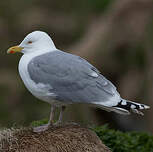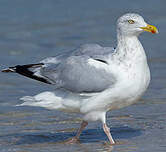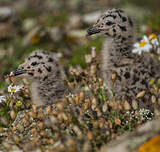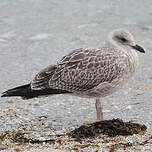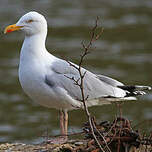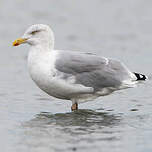European Herring Gull
Larus argentatus - Goéland argenté
Identification
Among the large gulls, the Silver group is a complex group found on both the North American and Eurasian continents. Currently, five different taxa are recognized in this group, although 1 or 3 species may be recognized according to classifications. For the IOC followed by oiseaux.net, 3 are recognized: the European argentatus, the Asian vegae and the American smithsonianus. This sheet is devoted to the species Larus argentatus, which is itself subdivided into two subspecies, the nominal argentatus from northern Europe and argenteus from western Europe, including France. Consequently, the detailed description below will refer to the latter. The European Herring Gull of the ssp argenteus is the smallest of the two subspecies. It is short-legged, with a relatively rounded head that gives it a gentle look and a moderately sized bill, with the male being bigger and stockier than the female. It has the palest grey in the aforementioned Silver group, approximately equivalent to that of the Laughing Gull. It has an ivory-yellow to pale yellow eye surrounded by an orange orbital ring. Its bill is yellow to orange with a red vermilion spot at the level of the gonys. Its culmen is coloured the same as its bill. Its legs are pink. In flight, one must pay attention to the pattern of the wingtip, preferably with a photo. The primary remiges have black on their distal portion, spanning more than the length of the P10, the outermost one, then decreasing to very little or none at all on the P5. The P9 and P10 are white-tipped. The tip of the P10 can be entirely white, or white with two very small black triangles, one on each vane, being the most common, or finally white with a small complete black subterminal bar, more rarely.In winter, the head of the adult is covered in small brown spots and the facial region darkens. The adult of the nominate subspecies argentatus of Northern Europe stands out due to its larger size, stronger bill, and darker shade of gray on the upper parts. This is noticeably darker, which is especially evident when compared to the European Herring Gull. The darkest individuals may superficially resemble the paler Brown Gulls of the graellsii subspecies. The argenteus juvenile appears from a distance to be the same color as milk coffee. This is the palest of the juveniles of the group. Three characteristics are diagnostically evident. The first, visible when the bird is perched, relates to the tertials; they are a rather dark brown with a typically scalloped pale beige border. The second happens with the greater coverts, which are pale beige with brown marks, like the other juveniles. This gives the upper wing a paler overall appearance than the other young gulls, which can be clearly seen when the bird is in flight. When in flight, the inner primaries are paler than the outer ones, and the secondaries form a paler window around the hand of the wing, particularly evident against the pale sky. The young gull reaches adult plumage by its 4th year, or 5th year. It would be cumbersome to describe all the immature plumages. It is better to refer to the images in the gallery that illustrate them. From its 2nd yearonwards, gray appears in the plumage and its quality helps with the identification.
Subspecific information 2 subspecies
- Larus argentatus argentatus (Scandinavia to the Kola Pen.. nw Russia.)
- Larus argentatus argenteus (Iceland, nw Europe)
Foreign names
- Goéland argenté,
- Gaviota argéntea europea,
- gaivota-prateada-europeia,
- Silbermöwe,
- ezüstsirály,
- Zilvermeeuw,
- Gabbiano reale nordico,
- gråtrut,
- Gråmåke,
- čajka striebristá,
- racek stříbřitý,
- Sølvmåge,
- harmaalokki,
- Haringmeeu,
- gavià argentat de potes rosa,
- Silfurmáfur,
- mewa srebrzysta,
- sudrabkaija,
- srebrni galeb,
- Серебристая чайка,
- セグロカモメ,
- 银鸥,
- gråtrut,
- 銀鷗〔黑脊鷗〕,
Voice song and call
Habitat
The European Herring Gull is mainly coastal for breeding, more than other gulls, but can travel inland for food all year round on large bodies of water, agricultural land and landfills. It prefers to nest in colonies on wild, rocky and steep coasts, rocky or grassy islands, dunes, gravel piles in the coastline, marshes, buildings, and for northern birds on tundra with reeds or hummocks and on river islands.
Behaviour character trait
The European Herring Gull is the common gull of the French Atlantic coast, sociable, easily visible, not shy, sometimes bold if there is food to be picked up.
For this reason, it is particularly attracted to fishing ports, various dumps or fields at the time of plowing. It can be observed in large numbers in these places as well as on the resting-sleeping places where they gather for the night. It is colonial for reproduction and observation of an active colony with its well-colored adults does not lack visual and sound appeal. Our birds of temperate latitudes are sedentary while the argentatus of the north, subject to more severe winter conditions, are migrants and join the argenteus around the North Sea. These seagulls are still well connected to the marine environment for food. They do not hesitate to move away from several 10 km from the coast to search for their food. Its English name is not Herring Gull, is it not? That is, the herring gull.Flight
Dietfeeding habits
The European Herring Gull has a varied diet and exploits all available resources opportunistically. It goes with the most abundant and/or most available option.
Its diet includes invertebrates and marine and terrestrial vertebrates depending on the period and circumstances. It is, of course, primarily piscivorous, especially during the breeding period. It exploits the coast and the open sea up to several hundred kilometres from the coast. It follows fishing boats. It also collects crustaceans such as crabs, marine worms, molluscs, echinoderms (sea urchins and starfish), etc. It also behaves as a scavenger, collecting dead animals thrown ashore by the sea. Fishing ports also attract it. Inland it is interested in earthworms, insects, molluscs and small rodents. It can also attack birds, particularly eggs and young of colonial species such as gulls or terns. Finally, side less attractive, it regularly frequents landfills with edible waste where it joins many other detritophage that are unregarding and followers of the law of least effort.Reproduction nesting
The breeding season begins in March in the south of its range and extends until May in the far north.
The species is monogamous. There is only one nesting attempt per year, and a second attempt only emerges under certain conditions if the first attempt fails. Breeding is colonial, with colonies ranging from hundreds to thousands of pairs. The nest is a shallow cup made of materials from the environment, placed directly onto the substrate in a depression, generally well sheltered by a rock or grass tuft. The female lays an average of three very cryptic, green-tinged eggs marked with dark spots. Incubation begins with the laying of the first egg and lasts for around four weeks. The chicks are semi-precocial; they must be kept warm for a few days until their homeothermy is established. They will be fed by both parents for 11-12 weeks, but they are able to fly at 45-50 days.Geographic range
The subspecies argenteus is found on the coasts of Western Europe in Iceland, the Faroe Islands, the British Isles, France and Germany. It is sedentary there. The argentatus from the north nest from Denmark, around Fenno-Scandia to the Kola Peninsula in Russia. They are migratory and winter from the North Sea to the Gulf of Gascony.
Threats - protection
IUCN conservation status
concern
in the Wild
threatened
evaluated
The species is not threatened. The population of European Herring Gulls (argentatus) has been stable in the last decades, whereas the L. a. argenteus has been decreasing after a former growth phase. With the current evolution, if nothing changes, it is estimated that the population of argenteus will continue to decrease by about 5 to 10% per year. Better waste management is probably at the root of this decrease.
Sources of information
- IOC World Bird List (v14.2), Gill, F and D Donsker (Eds). 2024-04-18.
- Atlas des oiseaux de France métropolitaine. Nidification et présence hivernale. , Issa Nidal et Muller Y
- Gulls of Europe, Asia and North America, OLSEN K. M. et LARSSON H.
- Avibase, Lepage Denis
- BirdLife International, BirdLife International
- Birds of the World, The Cornell Lab of Ornithology
Other sources of interest
 Specification sheet created on
19/07/2023 by Jean François
Specification sheet created on
19/07/2023 by Jean FrançoisTranslation by AI Oiseaux.net
© 1996-2025 Oiseaux.net
- Accipitriformes
- Aegotheliformes
- Anseriformes
- Apodiformes
- Apterygiformes
- Bucerotiformes
- Caprimulgiformes
- Cariamiformes
- Casuariiformes
- Charadriiformes
- Ciconiiformes
- Coliiformes
- Columbiformes
- Coraciiformes
- Cuculiformes
- Eurypygiformes
- Falconiformes
- Galliformes
- Gaviiformes
- Gruiformes
- Leptosomiformes
- Mesitornithiformes
- Musophagiformes
- Nyctibiiformes
- Opisthocomiformes
- Otidiformes
- Passeriformes
- Pelecaniformes
- Phaethontiformes
- Phoenicopteriformes
- Piciformes
- Podargiformes
- Podicipediformes
- Procellariiformes
- Psittaciformes
- Pterocliformes
- Rheiformes
- Sphenisciformes
- Steatornithiformes
- Strigiformes
- Struthioniformes
- Suliformes
- Tinamiformes
- Trogoniformes

